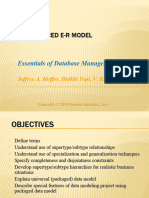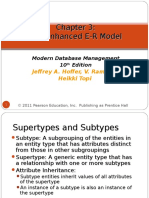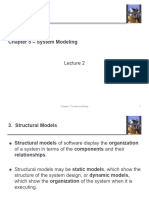Lect 14 EER Model
Lect 14 EER Model
Uploaded by
Chaudhary TahaCopyright:
Available Formats
Lect 14 EER Model
Lect 14 EER Model
Uploaded by
Chaudhary TahaCopyright
Available Formats
Share this document
Did you find this document useful?
Is this content inappropriate?
Copyright:
Available Formats
Lect 14 EER Model
Lect 14 EER Model
Uploaded by
Chaudhary TahaCopyright:
Available Formats
THE ENHANCED E-R MODEL
Modern Database Management
11th Edition
Jeffrey A. Hoffer, V. Ramesh,
Heikki Topi
© 2013 Pearson Education, Inc. Publishing as Prentice Hall
1
OBJECTIVES
Define terms
Understand use of supertype/subtype relationships
Understand use of specialization and generalization techniques
Specify completeness and disjointness constraints
Develop supertype/subtype hierarchies for realistic business
situations
Develop entity clusters
Chapter 3 © 2013 Pearson Education, Inc. Publishing as Prentice Hall
2
SUPERTYPES AND SUBTYPES
Enhanced ER model: extends original ER model with
new modeling constructs
Subtype: A subgrouping of the entities in an entity type that
has attributes distinct from those in other subgroupings
Supertype: A generic entity type that has a relationship with
one or more subtypes
Attribute Inheritance:
Subtype entities inherit values of all attributes of the
supertype
An instance of a subtype is also an instance of the supertype
Chapter 3 © 2013 Pearson Education, Inc. Publishing as Prentice Hall
3
Figure 3-1 Basic notation for supertype/subtype notation
a) EER
notation
Chapter 3 © 2013 Pearson Education, Inc. Publishing as Prentice Hall
4
Figure 3-1 Basic notation for supertype/subtype notation (cont.)
b) Microsoft
Visio
Notation
Different modeling tools may have different notation for the same
modeling constructs.
Chapter 3 © 2013 Pearson Education, Inc. Publishing as Prentice Hall
5
Figure 3-2 Employee supertype with three subtypes
All employee subtypes
will have employee
number, name, address,
and date hired
Each employee subtype
will also have its own
attributes
Chapter 3 © 2013 Pearson Education, Inc. Publishing as Prentice Hall
6
RELATIONSHIPS AND SUBTYPES
Relationships at the supertype level indicate that
all subtypes will participate in the relationship
The instances of a subtype may participate in a
relationship unique to that subtype. In this
situation, the relationship is shown at the subtype
level
Chapter 3 © 2013 Pearson Education, Inc. Publishing as Prentice Hall
7
Figure 3-3 Supertype/subtype relationships in a hospital
Chapter 3 © 2013 Pearson Education, Inc. Publishing as Prentice Hall
8
GENERALIZATION AND SPECIALIZATION
Generalization: The process of defining a
more general entity type from a set of more
specialized entity types. BOTTOM-UP
Specialization: The process of defining
one or more subtypes of the supertype and
forming supertype/subtype relationships.
TOP-DOWN
Chapter 3 © 2013 Pearson Education, Inc. Publishing as Prentice Hall
9
Figure 3-4 Example of generalization
a) Three entity types: CAR, TRUCK, and MOTORCYCLE
All these types of vehicles have common attributes
Chapter 3 © 2013 Pearson Education, Inc. Publishing as Prentice Hall
10
Figure 3-4 Example of generalization (cont.)
b) Generalization to VEHICLE supertype
So we put
the shared
attributes in
a supertype
Note: no subtype for motorcycle, since it has no unique
attributes
Chapter 3 © 2013 Pearson Education, Inc. Publishing as Prentice Hall 11
Figure 3-5 Example of specialization
a) Entity type PART
Only applies to
manufactured parts
Applies only to purchased parts
Chapter 3 © 2013 Pearson Education, Inc. Publishing as Prentice Hall
12
Figure 3-5 Example of specialization (cont.)
b) Specialization to MANUFACTURED PART and PURCHASED PART
Created 2
subtypes
Note: multivalued composite attribute was replaced
by an associative entity relationship to another entity
Chapter 3 © 2013 Pearson Education, Inc. Publishing as Prentice Hall
13
CONSTRAINTS IN SUPERTYPE/SUBTYPE
RELATIONSHIPS
Completeness Constraints: Whether
an instance of a supertype must also be a
member of at least one subtype
Total Specialization Rule: Yes (double line)
Partial Specialization Rule: No (single line)
Chapter 3 © 2013 Pearson Education, Inc. Publishing as Prentice Hall
14
Figure 3-6 Examples of completeness constraints
a) Total specialization rule
Chapter 3 © 2013 Pearson Education, Inc. Publishing as Prentice Hall
15
Figure 3-6 Examples of completeness constraints (cont.)
b) Partial specialization rule
Chapter 3 © 2013 Pearson Education, Inc. Publishing as Prentice Hall
16
CONSTRAINTS IN SUPERTYPE/SUBTYPE
RELATIONSHIPS
Disjointness Constraints: Whether an
instance of a supertype may simultaneously
be a member of two (or more) subtypes
Disjoint Rule: An instance of the supertype can
be only ONE of the subtypes
Overlap Rule: An instance of the supertype
could be more than one of the subtypes
Chapter 3 © 2013 Pearson Education, Inc. Publishing as Prentice Hall
17
Figure 3-7 Examples of disjointness constraints
a) Disjoint rule
Chapter 3 © 2013 Pearson Education, Inc. Publishing as Prentice Hall
18
Figure 3-7 Examples of disjointness constraints (cont.)
b) Overlap rule
Chapter 3 © 2013 Pearson Education, Inc. Publishing as Prentice Hall
19
CONSTRAINTS IN SUPERTYPE/SUBTYPE
RELATIONSHIPS
Subtype Discriminator: An attribute of the
supertype whose values determine the target
subtype(s)
Disjoint – a simple attribute with alternative values to
indicate the possible subtypes
Overlapping – a composite attribute whose subparts
pertain to different subtypes. Each subpart contains a
Boolean value to indicate whether or not the instance
belongs to the associated subtype
Chapter 3 © 2013 Pearson Education, Inc. Publishing as Prentice Hall
20
Figure 3-8 Introducing a subtype discriminator (disjoint rule)
Chapter 3 © 2013 Pearson Education, Inc. Publishing as Prentice Hall
21
Figure 3-9 Subtype discriminator (overlap rule)
Chapter 3 © 2013 Pearson Education, Inc. Publishing as Prentice Hall
22
Figure 3-10 Example of supertype/subtype hierarchy
Chapter 3 © 2013 Pearson Education, Inc. Publishing as Prentice Hall
23
ENTITY CLUSTERS
EER diagrams are difficult to read when
there are too many entities and relationships.
Solution: Group entities and relationships
into entity clusters.
Entity cluster: Set of one or more entity
types and associated relationships grouped
into a single abstract entity type
Chapter 3 © 2013 Pearson Education, Inc. Publishing as Prentice Hall
24
Figure 3-13a
Possible entity
clusters for Pine
Valley Furniture in
Microsoft Visio
Related
groups of
entities could
become
clusters
Chapter 3 © 2013 Pearson Education, Inc. Publishing as Prentice Hall
25
Figure 3-13b EER diagram of PVF entity clusters
More readable,
isn’t it?
Chapter 3 © 2013 Pearson Education, Inc. Publishing as Prentice Hall
26
Figure 3-14 Manufacturing entity cluster
Detail for a single cluster
Chapter 3 © 2013 Pearson Education, Inc. Publishing as Prentice Hall
27
PACKAGED DATA MODELS
Predefined data models
Could be universal or industry-specific
Universal data model = a generic or
template data model that can be reused as a
starting point for a data modeling project
(also called a “pattern”)
Chapter 3 © 2013 Pearson Education, Inc. Publishing as Prentice Hall
28
ADVANTAGES OF PACKAGED DATA
MODELS
Use proven model components
Save time and cost
Less likelihood of data model errors
Easier to evolve and modify over time
Aid in requirements determination
Easier to read
Supertype/subtype hierarchies promote reuse
Many-to-many relationships enhance model flexibility
Vendor-supplied data model fosters integration with vendor’s
applications
Universal models support inter-organizational systems
Chapter 3 © 2013 Pearson Education, Inc. Publishing as Prentice Hall
29
Copyright © 2013 Pearson Education, Inc. Publishing as Prentice Hall
30
You might also like
- IM Ch05 Advanced Data Modeling Ed12Document38 pagesIM Ch05 Advanced Data Modeling Ed12Mohsin75% (4)
- ISO 9001 Quality Manual SampleDocument65 pagesISO 9001 Quality Manual SampleNicko Arya DharmaNo ratings yet
- The Enhanced E-R Model: Modern Database ManagementDocument33 pagesThe Enhanced E-R Model: Modern Database ManagementAbdur Rahman AwanNo ratings yet
- Chap 4Document32 pagesChap 4abdullahumerNo ratings yet
- The Enhanced E-R Model: Modern Database ManagementDocument33 pagesThe Enhanced E-R Model: Modern Database ManagementLei LeiNo ratings yet
- Hoffer Mdm12e PP Ch03Document31 pagesHoffer Mdm12e PP Ch03syria loverNo ratings yet
- Hoffer Mdm12e PP Ch03Document34 pagesHoffer Mdm12e PP Ch03Kiên Nguyễn TrungNo ratings yet
- Hoffer Mdm11e PP Ch03 GEDocument32 pagesHoffer Mdm11e PP Ch03 GEtmzmfkdlqm530100% (1)
- DB Chapter 03 The Enhanced ER ModelDocument28 pagesDB Chapter 03 The Enhanced ER ModelMuhammad Asif JavaidNo ratings yet
- Hoffer Edm PP ch03Document28 pagesHoffer Edm PP ch03Urvish BarapatreNo ratings yet
- Chapter 3 AbstractDocument19 pagesChapter 3 AbstractKhalid IbrahimNo ratings yet
- The Enhanced E-R ModelDocument21 pagesThe Enhanced E-R ModelArreref EiojNo ratings yet
- Objectives: The Enhanced E-R ModelDocument7 pagesObjectives: The Enhanced E-R ModelKristienalyn De AsisNo ratings yet
- Screenshot 2023-01-26 at 12.40.47 PMDocument26 pagesScreenshot 2023-01-26 at 12.40.47 PMaliabuzaina1422No ratings yet
- Lecture 4Document42 pagesLecture 4Ehab EmamNo ratings yet
- 7000 Chapter 1Document32 pages7000 Chapter 1Harish KasamNo ratings yet
- Relational Database Model (Part 1)Document32 pagesRelational Database Model (Part 1)Vegie SisonNo ratings yet
- Chapter-3 ER ModelDocument12 pagesChapter-3 ER ModelHala GharibNo ratings yet
- Supertype, SubtypeDocument31 pagesSupertype, SubtypeharryomharryNo ratings yet
- The Enhanced ER Model and Business RulesDocument26 pagesThe Enhanced ER Model and Business RulesDilara FiratNo ratings yet
- 3 - EtwrfDocument31 pages3 - EtwrfJustineCharlesTarreNo ratings yet
- Chapter 3Document26 pagesChapter 3battal2023513No ratings yet
- Ch03 EER HandDocument15 pagesCh03 EER HandMahira ZainabNo ratings yet
- Modern Database Management Slides - ch03Document33 pagesModern Database Management Slides - ch03tahir77No ratings yet
- Chapter 3Document38 pagesChapter 3kashafNo ratings yet
- Enhanced ERD4545Document41 pagesEnhanced ERD4545sandbox2244No ratings yet
- The Enhanced E-R Model and Business RulesDocument36 pagesThe Enhanced E-R Model and Business RulesYasser SabriNo ratings yet
- 04 The Enhanced E-R Model-NDNDocument20 pages04 The Enhanced E-R Model-NDNFILZA RAHMA MUFLIHAHNo ratings yet
- Enhanced E-R Model and Business RulesDocument20 pagesEnhanced E-R Model and Business RulesAbdirisak Mohamud0% (1)
- Modeling Data in The OrganizationDocument45 pagesModeling Data in The OrganizationArpit GulatiNo ratings yet
- EERD Lecture5Document29 pagesEERD Lecture5Mohsin SyedNo ratings yet
- The Enhanced E-R Model: Abasyn University, Peshawar 1Document32 pagesThe Enhanced E-R Model: Abasyn University, Peshawar 1roohullahzeshanNo ratings yet
- Information Management: MODULE 3: Enhanced ER ModelDocument183 pagesInformation Management: MODULE 3: Enhanced ER Modelcuneta ferrinoNo ratings yet
- Week 6 - Extended ER ModelsDocument24 pagesWeek 6 - Extended ER Modelsaselalybaeva42No ratings yet
- Advanced Data Modelling: CTI2F3Document20 pagesAdvanced Data Modelling: CTI2F3MDPNNo ratings yet
- Lec05 System Modeling Part2Document21 pagesLec05 System Modeling Part2Shohanur RahmanNo ratings yet
- The Enhanced E-R ModelDocument27 pagesThe Enhanced E-R ModelMark MumbaNo ratings yet
- Lecture-04 - EER ModelDocument48 pagesLecture-04 - EER ModelMuneeb ur RahmanNo ratings yet
- Chapter 13 (Online) : Object-Oriented Data Modeling: Jeffrey A. Hoffer, V. Ramesh, Heikki TopiDocument38 pagesChapter 13 (Online) : Object-Oriented Data Modeling: Jeffrey A. Hoffer, V. Ramesh, Heikki TopiAafi QaisarNo ratings yet
- UML Association Vs Aggregation Vs CompositionDocument1 pageUML Association Vs Aggregation Vs CompositionabouananeNo ratings yet
- Modeling Data in The OrganizationDocument39 pagesModeling Data in The OrganizationLidya IndrianiNo ratings yet
- Lecture 6 EERDDocument39 pagesLecture 6 EERDAman UllahNo ratings yet
- Enhanced ER Modeling Techniques Transparencies: © Pearson Education Limited, 2004 1Document22 pagesEnhanced ER Modeling Techniques Transparencies: © Pearson Education Limited, 2004 1Rea PagaraNo ratings yet
- Dbms-5-Carol - Advanced Data ModelingDocument45 pagesDbms-5-Carol - Advanced Data ModelingADE FIKRY MUSTOFANo ratings yet
- M3-FORMDOC - de Vera, Franz Millan P.Document7 pagesM3-FORMDOC - de Vera, Franz Millan P.Franz De Vera (Znarf)No ratings yet
- Ch05 Advanced Data Modeling Ed12Document39 pagesCh05 Advanced Data Modeling Ed12melody mgwenyaNo ratings yet
- Enhanced Entity Relationships ModelDocument27 pagesEnhanced Entity Relationships Modelbabylin_1988No ratings yet
- DatabaseDocument5 pagesDatabaseVince Jeus GalamitonNo ratings yet
- Chapter 3 The Enhanced ER Model (EER)Document23 pagesChapter 3 The Enhanced ER Model (EER)renad145No ratings yet
- Uml Chap 8.4 by DMMKDocument14 pagesUml Chap 8.4 by DMMKDr. Myat Mon KyawNo ratings yet
- Chpater (8) Part IIIDocument14 pagesChpater (8) Part IIIDr. Myat Mon KyawNo ratings yet
- CH 2Document62 pagesCH 2genetNo ratings yet
- UML Association Vs Aggregation Vs CompositionDocument4 pagesUML Association Vs Aggregation Vs CompositionGerardo Castro MtzNo ratings yet
- Enhanced ER Modeling Techniques TransparenciesDocument22 pagesEnhanced ER Modeling Techniques TransparenciesShri GaneshNo ratings yet
- UML Association Vs Aggregation Vs CompositionDocument1 pageUML Association Vs Aggregation Vs CompositionseeNo ratings yet
- The Enhanced ER Model and Business RulesDocument27 pagesThe Enhanced ER Model and Business Rulesdoruk-tufekci-6025No ratings yet
- ch-10 Advanced RelationshipsDocument33 pagesch-10 Advanced RelationshipsbhargaviNo ratings yet
- Ooad Unit3.2Document13 pagesOoad Unit3.2Divya PotharlankaNo ratings yet
- Object Oriented Programming Inheritance: Fundamentals and ApplicationsFrom EverandObject Oriented Programming Inheritance: Fundamentals and ApplicationsNo ratings yet
- Modern Data Access with Entity Framework Core: Database Programming Techniques for .NET, .NET Core, UWP, and Xamarin with C#From EverandModern Data Access with Entity Framework Core: Database Programming Techniques for .NET, .NET Core, UWP, and Xamarin with C#No ratings yet
- ISLAYMAIT Project 3Document10 pagesISLAYMAIT Project 3Chaudhary TahaNo ratings yet
- Boolean AlgebraDocument10 pagesBoolean AlgebraChaudhary TahaNo ratings yet
- sp22-bcs 092Document3 pagessp22-bcs 092Chaudhary TahaNo ratings yet
- Sp22-Bcs-092 (Lab Assignment 2)Document5 pagesSp22-Bcs-092 (Lab Assignment 2)Chaudhary TahaNo ratings yet
- Sigma CertificateDocument1 pageSigma CertificateChaudhary TahaNo ratings yet
- Apache Monitoring With PRTGDocument4 pagesApache Monitoring With PRTG21GlobalTecNo ratings yet
- Tally Hindi NotesDocument40 pagesTally Hindi NotesGaurav JacobNo ratings yet
- Bio Concepts PresentationDocument28 pagesBio Concepts PresentationDiah K. AyuNo ratings yet
- Cns MCQDocument14 pagesCns MCQkyNo ratings yet
- Confidex A5 Product Leaflet 18052017Document11 pagesConfidex A5 Product Leaflet 18052017René PazmiñoNo ratings yet
- DRMU Sudha Dairy Internship Report CompleteDocument6 pagesDRMU Sudha Dairy Internship Report CompletepiyushjhathebossNo ratings yet
- Service Promotion PDFDocument11 pagesService Promotion PDFDipto KhanNo ratings yet
- Overview of Heads of income-MTS-2022Document197 pagesOverview of Heads of income-MTS-2022GauravNo ratings yet
- Detailed Lesson Plan in ElectricalDocument7 pagesDetailed Lesson Plan in ElectricalJc Santos50% (2)
- Manual de Serviço: CCD-TRV118Document111 pagesManual de Serviço: CCD-TRV118LuizNo ratings yet
- 906F Excavator: Tough World. Tough EquipmentDocument2 pages906F Excavator: Tough World. Tough EquipmentXe Cơ GiớiNo ratings yet
- Organization Structure: Minister OF RailwaysDocument1 pageOrganization Structure: Minister OF Railwaysmaharshi DaddyNo ratings yet
- Material ManagementDocument18 pagesMaterial Managementgayatri_vyas1No ratings yet
- Quiz1 CryptographyDocument9 pagesQuiz1 CryptographyAlok GaurNo ratings yet
- Updated Blaw Past Papers by RNK-1Document90 pagesUpdated Blaw Past Papers by RNK-1muzamil azizNo ratings yet
- Lesson 8 Marketing ManagementDocument5 pagesLesson 8 Marketing ManagementNmNo ratings yet
- GCam Dev Settings ExplainedDocument6 pagesGCam Dev Settings ExplainedHanggono Ari Swasono100% (5)
- Service: Caddy Kasten/Kombi 1996Document11 pagesService: Caddy Kasten/Kombi 1996Jan Svein HammerNo ratings yet
- Cortex XDR-Windows Event CollectionDocument3 pagesCortex XDR-Windows Event Collectionpunzango73No ratings yet
- Intercompany Cross Charges TrainingDocument16 pagesIntercompany Cross Charges TrainingNatasha BhalothiaNo ratings yet
- Ages Student Declaration FormDocument1 pageAges Student Declaration FormMobashirah NasirNo ratings yet
- Walmart Case Study Unit 6.assignementDocument13 pagesWalmart Case Study Unit 6.assignementKyteNo ratings yet
- Its The Architecture PDFDocument4 pagesIts The Architecture PDFPankaaj PadmanabhanNo ratings yet
- Prac - Res. 1 Quarter 2 Module 6Document14 pagesPrac - Res. 1 Quarter 2 Module 6cloydsolis0No ratings yet
- 026 Republic vs. HidalgoDocument20 pages026 Republic vs. HidalgoRonald MorenoNo ratings yet
- ZARA OfficialDocument13 pagesZARA OfficialThuong Nguyet Le PhamNo ratings yet
- คู่มือรุ่น MSY JP09 13 15 18 24VF ปี 2561 2562Document24 pagesคู่มือรุ่น MSY JP09 13 15 18 24VF ปี 2561 2562wutthicsaNo ratings yet
- Chapter 13: Equity and Fairness in Reward ManagementDocument6 pagesChapter 13: Equity and Fairness in Reward ManagementhehehuhuNo ratings yet
- Sample Trend AnalysisDocument2 pagesSample Trend AnalysisMaribel ZafeNo ratings yet






























































































